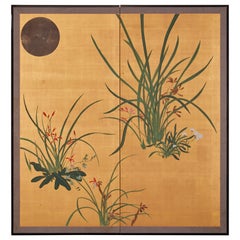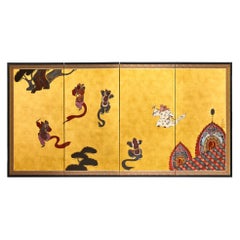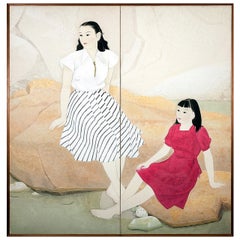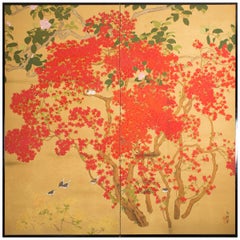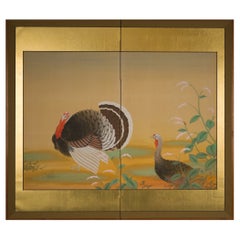20th Century Paintings and Screens
to
171
568
206
911
35
26
19
9
5
4
3
2
1
172
682
911
150
314
195
107
38
4
33
14
12
25
29
28
26
8
384
366
311
246
207
722
628
404
194
56
911
911
911
29
3
3
3
2
Period: 20th Century
Japanese Two Panel Screen: Moon and Flowers
Located in Hudson, NY
Showa period (1926 - 1989) painting with a strong design of exotic lilies and a cluster of nadeshiko (dianthus) under a silver moon on gold. This painting has a modern flair, which ...
Category
Japanese 20th Century Paintings and Screens
Materials
Silver
Japanese Four Panel Screen: Dancing Figures
Located in Hudson, NY
People dressed in ceremonial robes and masks celebrate the New Year. On New Year's eve a traditional Japanese custom is to ward off evil spirits by pretending to chase away people w...
Category
Japanese 20th Century Paintings and Screens
Materials
Gold, Gold Leaf
Vintage obi textile art " Moon phase II " by ikasu Silver, Black, Japan
By Kimono ikasu
Located in Setagaya City, JP
<< About this artwork >>
This artwork has been upcycled from a stunning obi, which is adorned with calligraphy weaving saying "moon" and "moonlight".
<< Period / Story >>
The obi...
Category
Japanese Japonisme Vintage 20th Century Paintings and Screens
Materials
Silver Leaf
Japanese Two-Panel Screen "Women in Western Dress"
Located in Hudson, NY
Japanese Two Panel Screen: Women in Western Dress, Nihonga style painting of two young women in Western style summer clothing, sitting at water's edge and cooling off by putting their feet in the water. Showa period painting...
Category
Japanese Showa Vintage 20th Century Paintings and Screens
Materials
Wood, Paper
Japanese Two-Panel Screen, Azalea Tree with Birds
Located in Hudson, NY
Beautifully painted Japanese two-panel screen with vibrant azalea tree with finches, camellia tree, and yellow azaleas. Mineral pigments and gold dust on gold silk background. Signat...
Category
Japanese 20th Century Paintings and Screens
Materials
Silk
Japanese Two Panel Screen, Turkeys
Located in Hudson, NY
Mineral pigments on silk, mounted on a gold panel, in silk border. Signature and seal read: Yoho.
Category
Japanese 20th Century Paintings and Screens
Materials
Silk
Framed Japanese Portrait of a Buddhist Priest by Goro Kamenaga
Located in Atlanta, GA
A gouache on silk painting of a Buddhist priest by Japanese painter Goro Kamenaga (1890-1955). The highly realistic painting depicts a figure in seate...
Category
Japanese Meiji Vintage 20th Century Paintings and Screens
Materials
Silk
Antique kimono textile art " Kobachi ~ Coral Collection ~ " by ikasu Pink, Japan
By Kimono ikasu
Located in Setagaya City, JP
This work is inspired by the coral color palette, and is framed in paulownia wood originally used for a kimono chest-of-drawers.
In this artwork, the aim was to capture the wide pal...
Category
Japanese Japonisme Vintage 20th Century Paintings and Screens
Materials
Silk, Wood
Japanese Important Tall Bronze Rabbit Girl Of Wonderland
Located in South Burlington, VT
"Rabbit Girl of Wonderland"
Japan, an important tall 35" hand cast bronze effigy of a young woman clutching a prize rabbit, by important national artisan ...
Category
Japanese Mid-Century Modern 20th Century Paintings and Screens
Materials
Bronze
$10,000 Sale Price
62% Off
Vintage kimono textile art "Flowers ~Life Circle~" by ikasu Pink, Black, Japan
By Kimono ikasu
Located in Setagaya City, JP
<< About this canvas >>
This canvas is crafted from three different haori fabrics, each adorned with a shibori dyeing flower motif going through entire fabric. These fabrics tell a ...
Category
Japanese Japonisme Vintage 20th Century Paintings and Screens
Materials
Canvas, Silk
China Beautiful Natural Mountain Waters Desktop "Painting"
Located in South Burlington, VT
This Chinese extraordinary natural stone marble "painting" of a mountain backdrop fronted by a peaceful body of water, is both unique and remarkable.
Called a dream stone Shih-hua it was cut from historic Dali marble found in the Cangshan mountains of western China. These mysterious mountains, unique in the world, are known for yielding incredible and fantastic natural landscaped works of art created over tens of millions of years from mineral inclusions that affected the process of ancient organic material which transformed into limestone and finally resulted in marble- a metamorphic hard stone.
Handsome custom hard wood frame
This particular dream stone is special- it is considered a master work of fine natural detail. We have had it framed in a handsome hardwood tabletop arts and crafts style frame...
Category
Chinese 20th Century Paintings and Screens
Materials
Marble
$2,280 Sale Price
40% Off
Inside Painted Snuff Bottles, Ten Pieces Snow Landscapes by Sun Sansong 1999
Located in Tainan, TW
Sun Sansong is the very early student of Wang Xisan. This collection is very rare and worth collecting. Ten Pieces are all his "FINE" works.
Artist: Sun ...
Category
Chinese Modern 20th Century Paintings and Screens
Materials
Glass
Vintage kimono textile art "Fern ~Connection to Nature~" by ikasu Black , Japan
By Kimono ikasu
Located in Setagaya City, JP
This work uses an antique tomesode (festive kind of kimono) with fern design to evoke feelings of tranquility, harmony, and appreciation for the beauty of the environment. Can be used both vertically and horizontally.
It is elegantly framed with paulownia wood originally used for kimono chest-of-drawers, and is filled with storytelling and sense of luxury.
I used pieces of kimono that could no longer be used as clothing and kiritansu chest-of-drawers that would normally be discarded to create the ultimate upcycled piece.
<< Explanation of colors and patterns >>
In Japanese traditional culture, ferns, particularly the Japanese painted fern (Athyrium niponicum), hold several meanings and symbolisms:
・Elegance and Beauty: Ferns are admired for their graceful, delicate appearance and intricate leaf patterns. In Japanese aesthetics, they are appreciated for their natural beauty and are often used in gardens, landscapes, and floral arrangements to add a sense of refinement and elegance.
・Resilience and Perseverance: Ferns are known for their ability to thrive in diverse environments, including shady forests, rocky cliffs, and damp soil. Their resilience in the face of challenging conditions is seen as a symbol of endurance and perseverance. In Japanese culture, ferns may represent the ability to overcome adversity and flourish despite obstacles.
・Connection to Nature and Tranquility: Ferns are native to forested areas and are often associated with the natural world. In Japanese traditional culture, they symbolize a deep connection to nature and the importance of maintaining harmony with the environment. The lush green foliage of ferns evokes feelings of tranquility and peacefulness, making them popular motifs in Zen gardens and traditional landscape paintings.
・Purity and Simplicity: Ferns are emblematic of simplicity and purity in Japanese aesthetics. Their unassuming beauty and understated elegance reflect the principles of wabi-sabi, an aesthetic worldview that values imperfection, impermanence, and simplicity. Ferns may be used in tea ceremonies, Ikebana (flower arranging), and other traditional arts to evoke a sense of tranquility and appreciation for life's fleeting moments.
Overall, ferns in Japanese traditional culture symbolize elegance, resilience, connection to nature, purity, and simplicity. Their presence in art, literature, and landscape design underscores their enduring significance as symbols of natural beauty and spiritual resonance.
<< Characteristics of the fabric >>
This vintage textile is hand-painted with a traditional Japanese technique called "yuzen".
<< About the frame >>
Kiritansu - chest-of-drawers for kimono, is traditionally made from paulownia wood, a uniquely Japanese material closely tied to the world of kimonos.
Paulownia wood is known as the lightest wood in Japan, prased for its natural luster, resistance to moisture, and resilience against cracking. Since ancient times, it has been used in crafting furniture, chests, and musical instruments.
During the Edo period, it became customary to store cherished kimonos in paulownia chests...
Category
Japanese Japonisme Vintage 20th Century Paintings and Screens
Materials
Silk, Wood
Japanese Antiques , Old Wrapping Paper , Tapestries
Located in Katori-Shi, 12
We present to you a precious old wrapping paper from the Taisho period.
This washi paper was used to wrap important items. It was made by overlapping multiple ledgers, and is chara...
Category
Japanese Taisho 20th Century Paintings and Screens
Materials
Paper
Japanese Two Panel Obara Screen: Mid Century Abstract
Located in Hudson, NY
Paper art screen (Obara) by Yamauchi Issei with abstract colored patterns consistent with work from the 1950's-60's.
Category
Japanese 20th Century Paintings and Screens
Materials
Wood, Paper
Vintage kimono textile art "Marble Story ~ Healing ~" by ikasu Grey, Japan
By Kimono ikasu
Located in Setagaya City, JP
This work uses a vintage kimono fabric with marble pattern, that makes it look like a real piece of marble.
The line in the middle symbolizes “kintsugi” - concept of wabi-sabi, which values imperfection, impermanence, and the beauty of aging.
It is elegantly framed with paulownia wood originally used for kimono chest-of-drawers, and is filled with storytelling and sense of luxury.
I used pieces of kimono that could no longer be used as clothing and kiritansu chest-of-drawers that would normally be discarded to create the ultimate upcycled piece.
<< Explanation and meaning of pattern and colors >>
Kintsugi (金継ぎ), which translates to "golden joinery" or "golden repair," is a traditional Japanese art form of repairing broken pottery with lacquer mixed with powdered gold, silver, or platinum. I used this tecnique here to "repair" antique kimono by transforming it into art work. Beyond its literal meaning of mending broken ceramics, kintsugi carries profound philosophical and cultural significance in Japanese tradition:
・Embracing Imperfection: Kintsugi celebrates imperfection and impermanence. Rather than disguising or concealing flaws, it highlights them, treating the breakage as part of the object's history. This philosophy encourages acceptance of imperfection as an essential aspect of life, beauty, and human experience.
・Wabi-Sabi Aesthetic: Kintsugi embodies the principles of wabi-sabi, an aesthetic worldview centered on the acceptance of transience and imperfection. Wabi-sabi values simplicity, authenticity, and the beauty of things that are imperfect, impermanent, and incomplete. Kintsugi exemplifies these principles by turning what might be considered flaws into features that enhance the object's beauty and character.
・Resilience and Transformation: The act of repairing broken things with precious metals symbolizes resilience and transformation. Instead of discarding or replacing the broken object, kintsugi honors its history and transforms it into something new and valuable. This reflects broader philosophical themes of overcoming adversity, finding beauty in imperfection, and embracing change.
・Honoring the Past: Kintsugi preserves and honors the history of the object. Rather than erasing or ignoring its past, it acknowledges and celebrates it. This aspect of kintsugi can be seen as a metaphor for honoring our own personal histories, including the challenges and setbacks we have faced, and recognizing how they have shaped us into who we are today.
・Spiritual and Philosophical Symbolism: Kintsugi has spiritual and philosophical implications, reflecting concepts such as the interconnectedness of all things, the cycle of life and death, and the pursuit of harmony and balance. The process of repairing broken objects with precious metals is seen as a metaphor for spiritual growth, enlightenment, and the journey towards wholeness.
Overall, kintsugi represents not only a practical technique for repairing ceramics but also a profound philosophical and cultural perspective on life, beauty, and the human experience. It embodies values such as resilience, acceptance, and the transformative power of embracing imperfection.
<< Characteristics of the fabric >>
This vintage textile is hand-painted with a traditional painting technique where the colors are added on wet surface, which creates an effect of marble.
<< About the frame >>
Kiritansu - chest-of-drawers for kimono, is traditionally made from paulownia wood, a uniquely Japanese material closely tied to the world of kimonos.
Paulownia wood is known as the lightest wood in Japan, prased for its natural luster, resistance to moisture, and resilience against cracking. Since ancient times, it has been used in crafting furniture, chests, and musical instruments.
During the Edo period, it became customary to store cherished kimonos in paulownia chests...
Category
Japanese Japonisme Vintage 20th Century Paintings and Screens
Materials
Gold Leaf
W.O.J. Nieuwenkamp (1874-1950) 'Wadah, Bali 1906’
Located in Amsterdam, NL
'Wadah, Bali 1906’
Signed upper right and with a pencil sketch annotated Boela(?), depot Stedelijk Museum Amsterdam and the artist’s stamp verso
Pen, brush and ink on paper laid do...
Category
Indonesian 20th Century Paintings and Screens
Materials
Paper
B32 Old Japanese 6panels, paper, folding Screen Dagasode 誰が袖 Byobu Kimono
Located in Niiza, JP
Dagasode 誰が袖 folding screen
Material: Paper & cloth pasted on paper, wooden frame
1 piece: Width 470 x Height 1300 x Depth 20 mm
Expanded size: Width 2860 mm
Folded size: Width 490 x...
Category
20th Century Paintings and Screens
Materials
Paper
Vintage kimono textile art "Sunset Timelapse ~Ephemerality~" by ikasu Red, Japan
By Kimono ikasu
Located in Setagaya City, JP
The art piece uses two sides - front and reverse - of the same kimono, to show beautiful sea surrounding Japan, in hues and in late sunset, as a timelapse.
The frame for this work is made of paulownia wood taken from antique Kiritansu - chest-of-drawers for kimono.
I use antique kiritansu that can’t be used as furniture anymore to create basis and frames for my works. It adds them even more authentic atmosphere of traditional wabisabi spirit. Can you feel it?
<< Period / Story >>
The kimono used in this piece was originally crafted during Showa period (around 1960ies).
<< Explanation and meaning of pattern and colors >>
Sea waves, depicted in two color variations here, are a symbol of transience and Impermanence in Japanese culture. The ebb and flow of the tides, the ever-changing currents, and the relentless motion of the waves serve as reminders of the fleeting nature of life. This artwork featuring the sea convey themes of impermanence, reminding viewers to cherish the present moment and appreciate the beauty of life's fleeting moments.
The theme of impermanence is strengthen by two colors of the sea - the lighter in early hues and the darker when the sun is just about to set in the sea.
<< About the frame >>
This artwork frame is crafted from paulownia wood, a uniquely Japanese material closely tied to the world of kimonos, and it serves to convey the refined beauty of Japanese nature.
Paulownia wood is known as the lightest wood in Japan, prased for its natural luster, resistance to moisture, and resilience against cracking. Since ancient times, it has been used in crafting furniture, chests, and musical instruments.
Paulownia wood is closely linked to kimono culture. During the Edo period (17th cent.~), it became customary to store cherished kimonos in paulownia chests...
Category
Japanese Japonisme Vintage 20th Century Paintings and Screens
Materials
Silk, Wood
Pair Dutch Oil Painting Portraits Night Market Signed R Van Molen
Located in Potters Bar, GB
You are viewing a gorgeous pair of Dutch oil paintings signed R Van Molen
Each depicts a night market scene in great detail
So intricate the brushwork is very detailed
Features the u...
Category
Vintage 20th Century Paintings and Screens
Materials
Paint
W.O.J. Nieuwenkamp (1874-1950) 'Ida Bagoes Raki, Bali 1906’
Located in Amsterdam, NL
'Ida Bagoes Raki, Bali 1906’
Signed middle right, annotated at the bottom and with artist’s stamp verso
Pen, brush and ink on paper, H. 26.3 x W. 10.8 cm
Ida Bagoes Raki, here 22 y...
Category
Indonesian 20th Century Paintings and Screens
Materials
Paper
Vintage Chinese Two Panel Colored stone Ansestoral Court Scene Panels
Located in Douglas Manor, NY
1764 Two individual Chinese panels hand painted with applied colored stone ansestoral figures in a court scene
Each panel 14x34"
Price is for 2 panels
Category
Vintage 20th Century Paintings and Screens
Materials
Stone
Japanese Two Panel Screen Moon Viewing
Located in Hudson, NY
Japanese two panel screen: Moon Viewing, painting of two noblewomen admiring the full moon outdoors. Extremely sophisticated execution of painting ove...
Category
Japanese Showa Vintage 20th Century Paintings and Screens
Materials
Silk, Wood, Paper
MIEKO - Vintage Asian Style Painting on Paper - Signed - Japan - Late 20th C.
Located in Chatham, ON
MIEKO - Vintage Asian style painting on watercolor paper - signed with the artist's chop mark and name - Japan - late 20th century.
Excellent vintage condition - bleed through to th...
Category
Japanese Anglo-Japanese 20th Century Paintings and Screens
Materials
Paint, Paper
Japanese Two Panel Screen Mountain Landscape on Gold Silk
Located in Hudson, NY
Nanga School; by female artist Kia Kozan. Showa Period (1926-1989) Translation: Kai Kozan 1867-1961, from Bungo area in Kyushu. Graduated from Bunchu-en Girls School. Signature and s...
Category
Japanese 20th Century Paintings and Screens
Materials
Paper
W.O.J. Nieuwenkamp (1874-1950) Statue of Vishnu Garuda, Bali, 1904
Located in Amsterdam, NL
Statue of Vishnu Garuda, Bali, 1904
Signed with initials
Pencil and ink on paper, 21.4 x 21.3 cm
Literature:
Bruce W. Carpenter, W.O.J. Nieuwenkamp. First European Artist in Bali, ...
Category
Indonesian 20th Century Paintings and Screens
Materials
Paper
W.O.J. Nieuwenkamp (1874-1950) Batur Temple and Batur Mountain before eruption
Located in Amsterdam, NL
Batur Temple and Batur Mountain before the eruption, Bali 1904
Signed, dated, and titled lower left and with artist's stamp verso
Pen, brush and ink on cardboard, H. 16.7 x W. 21.8...
Category
Indonesian 20th Century Paintings and Screens
Materials
Paper
Japanese Two Panel Screen: Flowers by River's Edge
Located in Hudson, NY
Mineral pigments on gilded silk with gilded bronze hardware. Signature reads: Shunkan.
Category
Japanese Vintage 20th Century Paintings and Screens
Materials
Bronze
Japanese Single Panel Moon Landscape
Located in Hudson, NY
Lacquer painting on wood.
Category
Japanese 20th Century Paintings and Screens
Materials
Lacquer
B48 Old Japanese Silver folding screen, Byobu 2panel
Located in Niiza, JP
Unfolded size: 1740 x 1750 x 20 mm
Foldable: 870 x 1750 x 40 mm, 7kg
Estimated size after packaging (sandwiched between 5 mm plywood):
9 cm x 95 cm x 185 cm Weight 16 KG
An atmosp...
Category
Japanese 20th Century Paintings and Screens
Materials
Paper
Chinese Extraordinary Outer Space Moonscape Natural Stone "Painting"
Located in South Burlington, VT
Extraordinary natural work, one of a kind. Custom framed
This Chinese extraordinary natural stone "painting" of an outer space nightscape suggests our universe of countless moons and stars and might remind us of a similar and unique evening experience in our lives. The powerful and colorful depiction is executed in natural dark green- almost black, cream and yellow (limonite mineral) colors. This is called a dream stone Shih-hua. They are cut from historic Dali marble found in the Cangshan mountains of western China. These mysterious mountains, unique in the world, are known for yielding incredible and fantastic natural landscaped works of art created over tens of millions of years from mineral inclusions that affected the process of ancient organic material which transformed into limestone and finally resulted in marble- a metamorphic hard stone.
This art form is centuries of years old since the Ming dynasty. Dream stones became favored art in the west particularly since the 19th century when French collectors named them Pierres de reve.
This thin marble stone "painting" is approximately 1/4" thick and is cut from a large slab of rough material revealing incredible patterns in soft white and gray colors. Its weight is surprisingly modest- easily hung with standard hardware.
Dimensions:
Frame: 25 inches high and 25 inches wide.
Site: 16.75" diameter
Provenance: Private Chinese collection, Yunnan, China.
History of dream stone "paintings":
Moonlight stones...
Category
Chinese 20th Century Paintings and Screens
Materials
Marble
$1,340 Sale Price
44% Off
B42 Japanese Antiques 6panels, Silver Paper, folding Screen, red-rimmed
Located in Niiza, JP
Silver foil folding screen
Material: Paper pasted on wooden frame
1 piece: Width 600 x Height 1745 x Depth 20 mm
Expanded size: Width 3640 mm
Folded size: Width 620 x Height 1745 x D...
Category
Japanese 20th Century Paintings and Screens
Materials
Paper
B41 Japanese Antiques 6panels, Silver Paper, folding Screen, brown-rimmed
Located in Niiza, JP
Material: Paper, wooden frame
1 piece: Width 435 x Height 1370 x Depth 18 mm
Expanded size: Width 2650 mm
Folded size: Width 455 x Height 1370 x Depth 100 mm, weight 9 kg
Packaging (...
Category
Japanese 20th Century Paintings and Screens
Materials
Paper
B36 Japanese Antiques Gold background flowers folding screen, 2-panel
Located in Niiza, JP
Material: Paper & Silk, wooden frame
1 piece: Width 760 x Height 1520 x Depth 20 mm
Expanded size: Width 1520 mm
Folded size: Width 760 x Height 1520 x Depth 40 mm, weight 6 kg
Packa...
Category
Japanese 20th Century Paintings and Screens
Materials
Silk, Paper
W.O.J. Nieuwenkamp (1874-1950) 'Stone statue in the temple at Madura, India'
Located in Amsterdam, NL
Stone statue in the temple at Madura, India, 1914
Signed with initials and dated, bottom left
Pencil on paper, 25.4 x 16.7 cm
Literature:
Ernst Braches en J.F. Heijbroek, W.O.J. ...
Category
Indian 20th Century Paintings and Screens
Materials
Paper
Haku Maki Japanese Woodblock "Poem 69-17" Signed
By Haku Maki
Located in New York, NY
Haku Maki (1924-2000) Japanese Woodblock Poem 69-17. This art is from the Poem collection. Signed and numbered in pencil. Edition 15/86. Color wood blocking with embossing. Measures ...
Category
Japanese Vintage 20th Century Paintings and Screens
Materials
Paper
Framed Korean Folk Painting of General Guan Gong
Located in Atlanta, GA
A Korean folk Shamanism watercolor on textile matted with woven brocade and presented in a wood frame with an oriental style metal hanging hardware. The painting was estimated to be from early 20th century circa 1910-1930s. It depicts Guan Yu (160-220AD), a legendary Chinese warrior and general from Eastern Han Dynasty. Long worshiped in China as a deity, across all three major religions, Guan Gong...
Category
Korean Folk Art 20th Century Paintings and Screens
Materials
Textile, Brocade
W.O.J. Nieuwenkamp (1874-1950) 'Part of the ring-wall of the Taj Mahal, India'
Located in Amsterdam, NL
Part of the ring-wall of the Taj Mahal, Agra, India, 1914
Signed with initials and dated bottom right
Black chalk on paper, 45.5 x 53 cm
Literature:
Ernst Braches en J.F. Heijbroek...
Category
Indian 20th Century Paintings and Screens
Materials
Paper
Japanese Two-Panel Screen, Rimpa Style Painting of Hollyhocks
Located in Hudson, NY
With the vibrant colors, and fine attention to detail and surface typical of a Rimpa painting. Using Rimpa style tarashikomi painting technique with mineral pigments on mulberry pape...
Category
Japanese 20th Century Paintings and Screens
Materials
Paper
Japanese Two-Panel Screen Dog Resting Beside a Thorny Hedge
Located in Hudson, NY
Japanese two-panel screen: Dog Resting Beside a Thorny Hedge, Showa period (1926 - 1989) painting of a white dog through an exaggerated thorny ...
Category
Japanese Showa 20th Century Paintings and Screens
Materials
Wood, Paper
Chinese Reverse Painting on Glass Empress Dowager Cixi 1st Half of 20th Century
Located in Ottawa, Ontario
A CHINESE REVERSE PAINTING ON GLASS
OF Empress Dowager Cixi
1st Half of 20th Century.
Fine painting on glass of
Empress Cixi seating on a throne
in or...
Category
Chinese Chinese Export 20th Century Paintings and Screens
Materials
Glass
W.O.J. Nieuwenkamp (1874-1950) Four Balinese, 1910
Located in Amsterdam, NL
Four Balinese, 1910
Signed and dated bottom left
Pencil and ink on paper, 15.6 x 23 cm
Literature:
W.O.J. Nieuwenkamp, Zwerftochten op Bali, Amsterdam, 1910, p. 36
Category
Indonesian 20th Century Paintings and Screens
Materials
Paper
Taisho Period Painted Silk Screen Depicting Nesting Cormorants by Asami Joujou
Located in Stamford, CT
An exquisite Taisho period screen depicting nesting cormorants painted on raw silk with gold fleck by Japanese artist Asami Joujou (b. 1890 in Himeiji, Japan-d. 1974), circa 1912-1926.
Category
Japanese Taisho Vintage 20th Century Paintings and Screens
Materials
Silk
Japanese Two Panel Screen: Pheasant and Snow Covered Bamboo
Located in Hudson, NY
Early Taisho period painting (1912 - 1926) in mineral pigments on mulberry paper with a silk brocade border. Artist signature reads: Kisho saku. Kisho Shibahara (1885-1954).
Category
Japanese Taisho 20th Century Paintings and Screens
Materials
Paper
Decorative panel entitled “Fragmentations – X”. Artisan work.
Located in Saint-Ouen, FR
Decorative panel entitled “Fragmentations – X” in inlaid and patinated brass. Glossy varnish finish.
Unique piece.
Dimensions: H 85 x W 65 cm
Reference: LS63782900A/2
Category
20th Century Paintings and Screens
Materials
Brass
Decorative panel entitled “Fragmentations – IX”. Artisan work.
Located in Saint-Ouen, FR
Decorative panel entitled “Fragmentations – IX” in inlaid and patinated brass. Glossy varnish finish.
Unique piece.
Dimensions: H 85 x W 65 cm
Reference: LS63782900/2
Category
20th Century Paintings and Screens
Materials
Brass
Japanese Two-Panel Screen, Young Pine in Snow
Located in Hudson, NY
Beautifully painted by Kido So (1899 - 1984). Born in Kyoto So studied painting at the Kyoto Municipal School of Painting under Yamamoto Shunkyo (1871...
Category
Japanese Vintage 20th Century Paintings and Screens
Materials
Silk
Japanese Two Panel Screen Peonies In the Mist
Located in Hudson, NY
Japanese Two Panel Screen: Peonies In the Mist. Showa period (1926 - 1945) painting in oil on canvas of peonies with gold and silver dust clouds. Signature reads, Seishu.
Category
Japanese Showa Vintage 20th Century Paintings and Screens
Materials
Gold Leaf, Silver Leaf
Lovely Japanese 18th-19th Century Edo or Meiji Scroll Painting Seven Lucky God
Located in Amsterdam, Noord Holland
Interesting and finely painted Japanese painting.
Provenance: From an old family from Kyoto.
width of about 62.0 cm axial destination width of about 67.8 cm × length of about 1...
Category
Japanese Meiji 20th Century Paintings and Screens
Materials
Bronze
$1,320 Sale Price
20% Off
Japanese Four Panel Screen: Scotties Under Roses
Located in Hudson, NY
Modern painting in mineral pigments on mulberry paper with a silk brocade border.
Category
Japanese 20th Century Paintings and Screens
Materials
Brocade, Silk, Paper
Japanese Two Panel Screen: Bamboo with Calligraphy Poem
Located in Hudson, NY
Moon and bamboo in ink on gold paper with red and black lacquered negoro frame. (Meiji period) Calligraphy reads: Beauty in ink painting with standing woods and branches, like in par...
Category
Japanese Antique 20th Century Paintings and Screens
Materials
Paper
Japanese Two-Panel Screen Pink and White Magnolias in Early Bloom
Located in Hudson, NY
Japanese two-panel screen: Pink and white magnolias in early bloom, Taisho period (1912-1926) painting of Japanese magnolia tree branches as the flowers...
Category
Japanese Taisho Vintage 20th Century Paintings and Screens
Materials
Silk, Wood, Paper
Japanese Two Panel Screen: Bamboo and Manchurian Crane
Located in Hudson, NY
Kano style painting in mineral pigments on silk with a silk brocade border.
Category
Japanese 20th Century Paintings and Screens
Materials
Brocade, Silk
Painting of Guanyin Qing Dynasty 19/20th Century Color on Silk
Located in West Palm Beach, FL
A painting of Guanyin
Qing Dynasty 19/20th century
color on silk;
The deity depicted floating, attired in long robes, adorned with jewels and wearing...
Category
20th Century Paintings and Screens
Materials
Silk
Japanese Four Panel Screen, Snowy Mountain Landscape
Located in Hudson, NY
Hinoki (Japanese red pine) and other deciduous trees in mineral pigments on mulberry paper. Signature reads: Yosui.
Category
Japanese 20th Century Paintings and Screens
Materials
Paper
Asian Chinese Ancient Warriors Hand-Painted
Located in WEST PALM BEACH, FL
These stunning paintings of ancient warriors in full costume offer a dramatic and colorful palate for a room decor, circa 1950.
Category
Chinese Other 20th Century Paintings and Screens
Materials
Fabric, Paint
$4,800 / set
W.O.J. Nieuwenkamp (1874-1950) 'Four outrigger proa’s on the beach of Kusambe'
Located in Amsterdam, NL
Four outrigger proa’s on the beach of Kusambe, Bali, 1937
Signed with initials, dated and described with location bottom left
Pencil and ink on paper, 29.7 x 35 cm
Category
Indonesian 20th Century Paintings and Screens
Materials
Paper
Early Communist Era Signed Chinese Plaque With Jade Carvings & Rosewood Frame
Located in Vancouver, British Columbia
Rare Chinese Maoist Communist Era Large Plaque with intricate jade carvings of young recruits fencing and watching while in the presence of a commandeering teacher. Fabulous display ...
Category
Chinese Chinese Export Vintage 20th Century Paintings and Screens
Materials
Jade
W.O.J. Nieuwenkamp (1874-1950) 'Meru in Kesiman, Bali 1906’
Located in Amsterdam, NL
'Meru in Kesiman, Bali 1906’
Signed lower centre and annotated lower left
Pen, brush and ink on cardboard, H. 24.4 x W. 17.1 cm
The stately grandeur of the architecture of South Ba...
Category
Indonesian 20th Century Paintings and Screens
Materials
Paper
Japanese Two-Panel Screen, Ferns and Young Pine
Located in Hudson, NY
Delicately painted on mulberry paper, signature and seal read: Shiko. The artist, Sakakibara Shiko, (1895-1969) was born in Kyoto.
Measures: 28.5" H X 73.5" W
72.39 X 186.69 (in ...
Category
Japanese 20th Century Paintings and Screens
Materials
Paper, Wood
Recently Viewed
View AllMore Ways To Browse
Lattice Panel Wood
Hanging Japanese Screen
Japanese Lattice
Japanese 19th Century Meiji Period Silk Painting
Japanese Buddhist Screen
Japanese Carved Screen
Japanese Screens And Doors
Japanese Autumn Screen
Japanese Screens Six Fold
Japanese Wood Room Divider
Kyoto Silk Painting
Japanese Dragon Painting
Japanese Birds Painted On Silk
Heian Period
Japanese Crane Panel
Japanese Divider Screen
Japanese Pheasant
Japanese Screen Chrysanthemums
